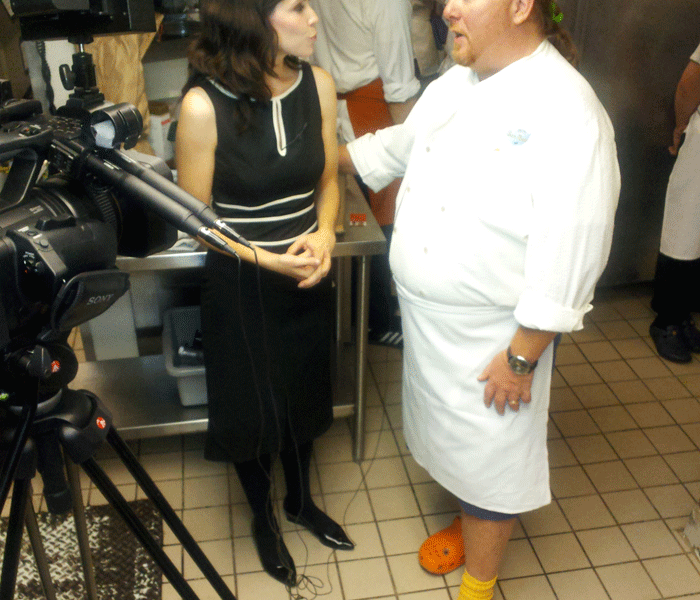
On Wednesday night, at Guastavino’s under the 59th Street Bridge, we tasted the new face of Italian food in New York. There was a trio of bread-forward canottini from Jim Lahey of Sullivan Street Bakery, truffle-oxtail tartlet with autumn squash from Nick & Toni’s chef Joe Realmuto, Sicilian pizza, macaroni and beans, and cauliflower fritters from Sal Basille and Francis Garcia of Artichoke’s Basille’s Pizza, and salumi from Cesare Casella of Salumeria Rosi.
What tied all these dishes together wasn’t just their Old World inspiration, but their locavore sensibility: They were all made from mostly New York grown ingredients: In fact this batch of salumi was Casella’s first made with Empire State meat.
Such a statement-making menu for Italian-American cooking wasn’t necessarily the intention of the James Beard Foundation’s annual fundraising gala–this year dubbed “Now that’s (sic) Italian”–but perhaps it’s not surprising. The cast of esteemed chefs–Marc Vetri, Missy Robins of A Voce, Matteo Bergamini of SD26, Nancy Silverton and Matt Molina of Mozza, and Michael White of Marea and Osteria Morini–were assembled by Mario Batali. (He dazzled attendees with his excellent Italian and signature apron-over-shorts-and-orange-crocs ensemble, as always.) All seemed to be channeling food ambassadors like Tony May and Lou DiPalo who have argued that what should shine about Italian cuisine in America is regional distinctiveness and excellent ingredients. Along these lines the host chef, John Stevenson of Guastavino’s event space, prepared sweetbread roulade with chestnut puree, a local shellfish risotto served in a mussel shell, and last-of-the-season grilled eggplant caponata.
The Gotham gala season is just getting underway, of course. (John Rose–of the family-run Rose Group that manages Gustavino’s and opened all the Cipriani event spaces–noted he had a very packed schedule between now and the New Year.) This fall gala is the James Beard’s foundation’s most important annual fundraiser: An entire table was filled with scholarship recipients: the Foundation has given away $4 million to culinary students in the last two decades.
They’re coming off a particularly busy event calender, thanks to its recently launched leadership awards–focused on chefs, farmers and decisionmakers who are helping to build a better food system–and their latest sustainability-focused dialog on Money, Media and Food. (In this interactive event filled with publishers, agribusiness heads and food community organizers, I had the pleasure of speaking on a panel moderated by Marion Nestle that included representation from the Food Network, the Ad Council and Grace Communications/Eat Well Guide, and provoked some intriguing discussion about what messages can change the way we eat and how much it costs to produce those messages.)
In her remarks to kick off the soldout dinner and live auction, foundation president Susan Ungaro couldn’t say enough about the foundation’s expanded mission, a trend seen in the community-based side-ventures of all the chefs in attendance. Joe Realmuto, as Edible East End readers will know, has been a leader in launching and supporting edible schoolyard projects on the South Fork of Long Island, while on the Upper West Side Nick & Toni’s has been a keystone buyer of Greenmarket produce.
And Cesare Casella, the International Culinary Institute’s Dean of Italian Studies, filled us in on his latest exploits as the International Culinary Center’s Italian Program, which includes work at the Center for Discovery, an innovative and enlightened farm-based rehabilitation facility in Sullivan County that takes care of 300 residents and 400 daycare clients aged 6 to 87, getting then to work in gardening, egg collecting, farm chores, cooking and seasonal Hudson Valley-style eating as part of their therapy.
Casella said they recently cooked and stored 6,000 pounds of pumpkin, although he’s most excited about their ramped up greenhouse production and the successful cross between a massive Italian cattle breed and a more manageable domestic Angus.
Like most New Yorkers, Beard was a fan of Chinese food: at the boarding house that James Beard’s mother managed, and where Beard was raised, the chef was Chinese, Ungaro recounted. But, like most New Yorkers, he was also a fan of Italian. Ungaro mentioned some early footage of Beard on the Today show making fresh pasta with a hesitant Bryant Gumble. “When you think that he was on TV teaching Americans how to make fresh pasta, when most Americans knew pasta as Ronzoni, that was pretty radical.”
A few years back, another foundation’s gala did feature Italian truffles, which were also featured in the gala menu in the agnolotti dal plin prepared by Batali and the seared sea scallops from Michael White. Scanning the room, with tables offering some memorable buffalo milk cheeses courtesy of Forever Cheese, wines from Banfi and Bastianich, and even tasty passed treats to fill you up before dinner, Ungaro described it as “a beautiful bazaar or piazza.”
Lahey seconded such admiration. Lately, he has been making little nests of egg pasta with New York grains (a recent dinner where it came with ragu brought tears to his eyes), and last night, cradling a big glass of red from Tuscany (La Mozza “I Perazzi” Morelino di Scansano 2009), he riffed on the many ways in which Italian cooking is used and abused, whether it is labeled Italianate or derided as “fauxtalian.”
The mounds of simple, biscuit-like canottini that guests were plucking from his table weren’t so much an homage to Italian ingredients–we’ve got great meat and cheese here too, he said–but an homage to something that grew out of a couple thousand years of accumulated food culture. It’s the “traditional practice and technique” that define good Italian food, Lahey said, wherever it is made.



